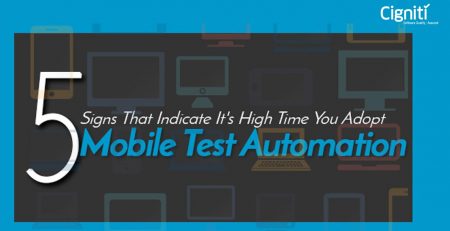Accelerate Digital Transformation With a “Mobile-First” Strategy
In today’s world, being connected anywhere and anytime is the most crucial aspect for anyone, and mobile phones as a device are one of the most critical enablers. With smartphones and internet connectivity, having access to content has become a click away. Purchase decisions and payment modes have been greatly influenced by the mobile landscape, so it has become important for companies to provide a great user experience across platforms and devices, with mobile being the prime device.
The latest research says that mobile device internet traffic has increased by 75% since 2015. The number of people using mobile devices to access the internet has climbed from one quarter to the next. For the first time, mobile traffic surpassed desktop traffic in Q1 2017. By August 2022, mobile devices accounted for 62.06% of total website traffic. A mobile phone of some form is used by 92.1% of internet users to access the web.
Setting a strategy that takes a mobile-first approach will help lay the groundwork for what is expected out of different teams and contribute to a unified customer experience. Understanding the various components will help you build a mobile testing strategy from scratch, but it won’t happen quickly. You may release new integrations with the assurance that users won’t experience any bizarre behavior that desktop users aren’t prone to by learning how to test on mobile devices, what tools to use, and which machines to test on.
From a testing and QA point of view, having a good test coverage and test plan to account for the mobile experience and then adapting to desktop versions is gaining importance. Testing on mobile apps or the mobile web would necessitate a different set of skills and tools than testing on the desktop version. Apps without a particular amount of functionality and authenticity won’t be used because mobile consumers continue to seek authentic mobile experiences—those that are context- and location-aware, personalized, and engaging.
Some challenges that are seen from a mobile standpoint are as follows:
Mobile Device Fragmentation: Device fragmentation is one of the main problems we run into when testing mobile apps. There are various mobile operating system (OS) versions and device models, each with a different screen size and resolution, manufacturer, keypad type, and platform support. It is envisioned that mobile applications would function on a variety of hardware with various configurations.
Multiple Mobile Variants Available: Since the release of Android 1.0, more than 500 million Android and 220 million iOS devices have been shipped. The vast array of mobile devices on the market, including handsets, smartphones, tablets, pads, and wearable technology, offers a great variety of scenarios for your mobile app to operate in. Additionally, even if a device is part of the same product family, the quality team cannot guarantee that tested applications will function flawlessly on other devices just because they are from the same product family due to potential differences in screen resolution, CPU, memory, OS optimization, and hardware.
Setting up a Mobile Device Lab: The mobile device lab is necessary to ensure that you have tested your software on a real device rather than just an emulator or simulator. Additionally, you should consider the many OS, device, screen, RAM, fragmentation, and other variables that may affect how well your application runs on a mobile device. However, the cost of establishing a mobile device lab is prohibitively expensive for many people.
Collaboration between Developers and Testers: Software development is approached differently by developers and testers. While a tester looks for every loophole in the solution, a developer seeks out novel ways to solve an issue. Many times, mature coworkers understand the significance of each step in the process and avoid letting their own preferences influence the result.
As agile testing methodology becomes more widely used, departmental walls are dissolving, forcing disparate teams to work together more intimately. More than ever, there is a need for developers and testers to communicate easily with one another.
How Cigniti and Browserstack Collaboration Aids in Overcoming These Obstacles
Cigniti helps clients successfully address the challenges of mobile app testing, including handling diverse screen resolutions, increased voice, video, and data capabilities, gesture-based applications, etc. Cigniti’s teams collaborate with various stakeholders to understand user demographics such as operating systems, versions, OEMs, geographies, and locales to determine the user composition and ensure a high probability of coverage for a broader profile of users.
Cigniti’s mobile testing service capabilities are ably supported by iNSta, a proprietary test platform that supports scriptless automation testing in various languages. The platform is integrated with Browserstack’s cloud-based test infrastructure and adopts an Agile and DevOps-based testing methodology to plan and conduct mobile testing. This approach is based on years of proven experience and helps integrate mobile engineering and mobile testing processes to provide business-critical benefits.
BrowserStack is the world’s leading software testing platform, powering over two million tests every day across 19 global data centers. With BrowserStack, one can test instantly on a wide range of real iOS and Android devices on the cloud. BrowserStack’s real device cloud provides teams and individual testers with 3000+ real devices and browsers for instant testing in real user conditions. With BrowserStack, your dev and QA teams can move fast while delivering an amazing experience for every customer, from testing your website to testing your mobile app.
The Cigniti-BrowserStack partnership helps customers with their testing needs and empowers the team with tools that enable them to achieve their testing goals.





Leave a Reply